Trying to decide between a Roomba from iRobot and a Shark robot vacuum? You’ve come to the right place. This page contains all the important things you need to know, condensed from hours of research.
I will compare the two brands in general, then specific models in each price tier.
Contents
- 1 General Differences between Shark Robot Vacuums and Roombas
- 2 Budget Category: Shark vs Roomba Comparison
- 3 Mid-tier Category: Shark vs Roomba Comparison
- 4 Premium Category: Shark vs Roomba Comparison
- 5
- 6 Shark Ion 750 vs Roomba 890
- 7 The Differences between the Robots
- 8 The Similarities between the Vacuums
- 9 Side By Side Comparison Chart
- 10 Other Live Deals
- 11 Features and Options Details
- 12 Frequently Asked Questions
- 12.1 Q. Which is better, Roomba or Shark?
- 12.2 Q. Can either of these robots continue where they left off?
- 12.3 Q. I have a dark colored floor, and the Ion 750 avoids it, what can I do?
- 12.4 Q. Can you program the robots manually or do I have to use the mobile app?
- 12.5 Q. Can I use these to clean any floor type?
- 12.6 Q. How often will the robot bang against my walls?
- 12.7 Q. I have oriental rugs with long fringe, will this be a problem?
- 12.8 Q. Will this clean every room at once?
- 13 What I Like About The Ion 750
- 14 What I like About The Roomba 890
- 15 In Conclusion
General Differences between Shark Robot Vacuums and Roombas
Sharks
- Only one main rotating brushroll
- 2 sidebrushes, one on each side, to help sweep debris into path of suction.
- Dollar for dollar, you get stronger suction with Shark robot vacuums.
- Quieter during operation than most other robot vacuums.
- Most models have adjustable power settings (low, medium, or high).
- Work with boundary tape to keep out of restricted areas.
Roombas
- Two main rotating brushrolls.
- Only 1 sidebrush to sweep debris into path of suction.
- Premium models are much better at navigation.
- World class customer support.
- Work with wireless beacons to stay out of restricted areas.
Given the huge selection of models to choose from, it wouldn’t be fair to compare the entry level robots to the premium ones. The following section divides the vacuums into 3 categories: budget, mid-tier, and premium.
Budget Category: Shark vs Roomba Comparison
All models in this category navigate randomly.
Recommended for households with simple layouts, e.g. 1 bedroom or studio.
Shark Ion 750 (aka R75)
The Shark Ion 750 is one of the most basic Shark robot vacuums. It is very affordable, quiet, and reasonably good at cleaning. The main downside is that it uses a random navigation pattern and may miss parts of the floor. If you can spend a bit more, go for the Shark Ion 850, which has more powerful suction.
Pros: inexpensive, quiet, good battery life, large dust bin, controllable via app and voice
Cons: random navigation (inefficient cleaning)
Recommended if: price is your only concern.
Shark Ion 850 (aka R85)
[easyazon_image align=”center” height=”300″ identifier=”B07FX7394L” locale=”US” src=”https://smartrobotichome.com/wp-content/uploads/2019/12/41fYwpO2d9L.jpg” tag=”img_shark-roomba-20″ width=”300″]The Shark Ion 850 is an upgrade from the 750. The most important upgrade is that it has much stronger suction. Like most other entry level robot vacuums, the Shark Ion 850 does not have logical navigation and therefore cleans randomly. It is affordable, quiet, and good at cleaning. If you are in the market for an entry level robot vacuum, the 850 is highly recommended.
Pros: inexpensive, powerful suction, good battery life, huge dust bin, controllable via app and voice
Cons: random navigation (inefficient cleaning)
Recommended if: you are looking for the best performance to price ratio in the entry level robot vacuum category.
Roomba e5
[easyazon_image align=”center” height=”250″ identifier=”B07QNM7YDM” locale=”US” src=”https://smartrobotichome.com/wp-content/uploads/2019/12/414YhDTXyL.jpg” tag=”img_shark-roomba-20″ width=”250″]The Roomba e5 is a very reliable robot vacuum with dual brushless rollers. Having two rotating bars give the robot more working surface area to pick up debris, and “brushless” means there are no bristles for long hair to get stuck in.
The main downside to the e5 is its price. The Sharks in this category perform equally well but cost less than the Roombas.
On the plus side, iRobot’s customer support is unparalleled in the industry.
Pros: dual brushless rollers (good for long hair and pets), very reliable, great customer support
Cons: random navigation, expensive for a random navigation robot
Recommended if: you are a fan of Roombas; you want a reliable robot vacuum with world class customer support.
If you are shopping for a vacuum in the budget category, the Shark vacuums are the better choice.
Both the Shark 750 and Shark 850 are quiet, and both outperform the Roomba when it comes to suction. Of the two Sharks, the 850 has stronger suction and is the one I recommend.
Unless you have very strong brand loyalty to iRobot, it makes more sense to pick up a Shark if you are looking for a robot vacuum in this category. Check out the R85 on Amazon.
Mid-tier Category: Shark vs Roomba Comparison
All models in this category have advanced sensors and logically navigates your house.
Recommended for households with 2 or more rooms and households with pets or long hair
Shark IQ Robot Vacuum (aka R101)
[easyazon_image align=”center” height=”300″ identifier=”B07SBKV115″ locale=”US” src=”https://smartrobotichome.com/wp-content/uploads/2019/12/41EA3gKrGrL.jpg” tag=”img_shark-roomba-20″ width=”300″]The Shark IQ robot has even stronger suction than the already impressive Shark 850.
If you have long hair, you know what it’s like to have to untangle the hair out of vacuum brushes. The R101 has a plastic comb built into the brush chamber to detangle hair as they are picked up, which makes maintenance a lot easier.
It also has the ability to navigate logically and lets you pick which rooms you want to be vacuumed.
However, it struggles when it comes to learning the layout of your home at first. With some layouts, this robot is simply unable to learn. This is Shark’s first attempt at a smart navigation robot and hopefully the issue will be fixed in the future.
Pros: self-cleaning brush (good for long hair and pets), can choose specific rooms to clean, app and voice control, cheaper than its Roomba counterpart
Cons: unreliable when it comes to mapping and navigation
Recommended if: you are looking for a robot with smart navigation but have a strict budget to stick to. Check out the Shark IQ Robot on Amazon.
Roomba 960
[easyazon_image align=”center” height=”300″ identifier=”B01ID8H6NO” locale=”US” src=”https://smartrobotichome.com/wp-content/uploads/2019/12/51n7mfrpPFL.jpg” tag=”img_shark-roomba-20″ width=”300″]Unlike the Shark IQ robot, the Roomba 960 has no problem learning the layout of homes. It’s smart, can recharge itself and resume cleaning where it left off, and is very reliable.
The dual rubber rollers on this robot pick up a lot of debris and does not entangle hair, making it easy to maintain.
Pros: dual brushless rollers, logical and efficient cleaning, recharge and resume.
Cons: does not empty itself
Recommended if: you are looking for the best bang for your buck.
This is my favorite vacuum and the one I recommend to everyone I know. It does everything you need a robot vacuum to do on a daily basis. See the Roomba 960 on Amazon.
If you are shopping for a robot vacuum with logical navigation, you can’t go wrong with the Roomba 960.
Even though it is more expensive than the Shark IQ Robot R101, it is a lot better at learning and navigating your house. The Shark struggles with mapping and takes a lot of tries to map out your house depending on the layout.
On the other hand, the Roomba 960 has been a solid performer ever since its release and has no problems mapping and navigating your home. The brushless rollers are easy to maintain. The ability to recharge and resume means it can clean an entire level of your home regardless of its layout and size.
It is my favorite robot vacuum on this list in terms of the amount of performance you get for the price. See the Roomba 960 on Amazon.
Premium Category: Shark vs Roomba Comparison
All models in this category have navigate your house logically and can empty their own dust bins.
Shark IQ Robot Vacuum with Self Empty (aka R101AE)
[easyazon_image align=”center” height=”300″ identifier=”B07S864GPW” locale=”US” src=”https://smartrobotichome.com/wp-content/uploads/2019/12/41LFAf9kTFL.jpg” tag=”img_shark-roomba-20″ width=”300″]The R101AE, or Shark IQ Auto Empty, is Shark’s take on the auto-emptying robot vacuum.
Unlike iRobot’s self-emptying models, the Shark does not use disposable bags. This mean the ongoing cost of using your vacuum is significantly reduced (the cost of dirt disposal bags add up quickly). It is also more environmentally friendly.
Like its little brother (the Shark R101) though, the R101AE also struggles with mapping and sometimes just refuse to learn the layout. Hopefully this will be fixed in a firmware update.
Pros: priced very reasonably for a self-emptying robot, self-cleaning brush, can choose specific rooms to clean, app and voice control,
Cons: unreliable when it comes to mapping and navigation
Recommended for: those looking for the best deal on an auto-emptying robot vacuum at a fraction of the price. See the Shark IQ Robot with Self Empty on Amazon.
Roomba i7+
[easyazon_image align=”center” height=”300″ identifier=”B07GNPDMRP” locale=”US” src=”https://smartrobotichome.com/wp-content/uploads/2019/12/41ElCTV0AOL.jpg” tag=”img_shark-roomba-20″ width=”300″]The Roomba i7+ improves on the Roomba 960 in every aspect: stronger suction, even smarter navigation, and the new ability to empty itself. (This was the first robot vacuum on the market to be able to do so.)
The only downside to this vacuum is its price. If money is no object and you want a reliable self-emptying robot vacuum, the Roomba i7+ is the obvious choice.
Pros: dual brushless rollers, logical and efficient cleaning, strong suction, empties itself.
Cons: expensive.
Recommended for: those who want the best quality regardless of cost. Check out the Roomba i7+ on Amazon.
If you are shopping for a self-emptying robot, the Roomba i7+ is the way to go. It is much better at learning the layout of your house and finding its way back to the dock.
If self emptying is really important to you but budget is also a concern, then maybe consider the Shark.
(If self emptying is not a must, go down a tier and pick up a Roomba 960 or Shark R101 to save a bunch of money.)
For those looking for the best self-emptying robot vacuum, the Roomba i7+ is the one I recommend. (The Roomba s9+ is technically even better but not included in this review due to its exorbitant price.) See the Roomba i7+ on Amazon.
The rest of this article compares the Shark Ion 750 to the Roomba 890. Click here if you are looking for a detailed comparison of the Shark Ion Robot Self-Empty vs Roomba i7.
Shark Ion 750 vs Roomba 890
Ever since home cleaning robots were introduced to the market, iRobot has lead the way. The Roomba line has become the standard all other manufacturers are held to. Shark introduced the Ion 750 to compete with the Roomba. Could this be the Roomba Killer everyone is waiting for?
For the rest of this article, I will compare these two specific vacuums in this Shark vs Roomba showdown. I will discuss their similarities and differences along with a side by side comparison of the two robots. I will also go in depth to uncover their features and options and tell you which one I believe is the better vacuum. If you just want to know the verdict: The Roomba 890 is still reigning champion.
The Differences between the Robots
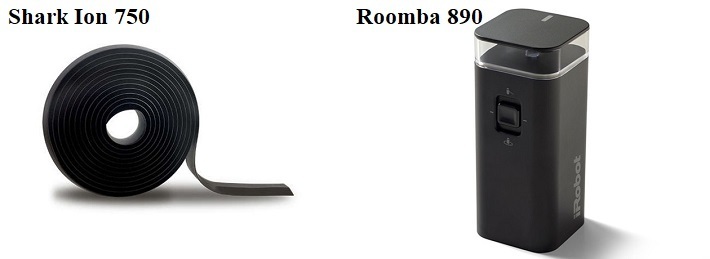
Each robot will be different in some way from the others. This list could make or break your decision.
- The Roomba 890 has about one inch larger diameter and three pounds heavier than the Ion 750.
- The Ion 750’s filters are HEPA rated; the 890’s are not.
- Shark uses Smart Sensor Navigation; iRobot uses iAdapt technology.
- The Ion 750 utilizes two side brushes where the Roomba 890 uses one.
- The battery recharge time for the Roomba is two hours; for the Ion, it is three hours.
- Ion 750 does not have a full bin indication; Roomba 890 does.
- Roomba makes use of Virtual Wall Barriers while the Ion has “Botboundary” Strips .
- The Ion 750 uses a full-width brush bar while the Roomba 890 uses two counter-rotating brushless extractors.
The Similarities between the Vacuums
[easyazon_image align=”none” height=”500″ identifier=”B075JRB2Z9″ locale=”US” src=”https://smartrobotichome.com/wp-content/uploads/2018/05/514er0fmafL.jpg” tag=”srh-easyazon-20″ width=”500″]
[easyazon_image align=”none” height=”500″ identifier=”B06XS31V18″ locale=”US” src=”https://smartrobotichome.com/wp-content/uploads/2018/05/419jhshvL.jpg” tag=”srh-easyazon-20″ width=”500″]
Sometimes knowing that one can do the same thing as the other is crucial to your purchase choice.
- Both robots have a mobile app for control.
- You can use voice controls with Amazon Alexa and Google Home on each model.
- The Ion 750 and the Roomba 890 have sensors for avoiding obstacles and ledges.
- Each robot uses a lithium-ion battery for power.
- Both will automatically return to the charging dock when the battery power is low.
- The runtime for each robot is about an hour under optimal conditions.
- Each vacuum connects to your home WiFi network.
- You can set, edit and delete schedules for both robovacs.
- Neither robot vac will auto-resume cleaning after charging the batteries.
- Both vacuums will spot clean specific areas you address.
Side By Side Comparison Chart
Let’s take a look at the two machines side by side in this handy little chart.
| Shark Ion 750 | Roomba 890 | |
| Battery Type | Lithium Ion | Lithium Ion |
| Charge Time | 180 minutes | 120 minutes |
| Run Time | 60 minutes | 60 minutes |
| Navigation/Mapping | Shark Smart Sensor | iAdapt |
| Filtration | HEPA | AeroVac High Efficiency |
| Pick Up | Single brush bar | Dual brushless extractors |
| Weight (pounds) | 5.5 | 8.4 |
| Dimensions (inches) | 12.6 x 12.6 x 2.6 | 13.9 x 13.9 x 3.6 |
| Remote Control | Shark App | Home App |
| Scheduling | Yes | Yes |
| Spot Clean | Yes | Yes |
| Automatic Recharge | Yes | Yes |
| Voice Controls | Yes | Yes |
| Entire Level Cleaning | No | No |
| Full Bin Indication | No | Yes |
| Side Brushes | 2 | 1 |
| WiFi Connect | Yes | Yes |
| Price | Check on Amazon | Check on Amazon |
Other Live Deals
Click to see all the robot vacuum deals on Amazon today.
Features and Options Details
Knowing what the two robots are capable of means little if you don’t know what those functions actually do. I will explain, in detail, those features for you here.
1. Filtration

Anything that uses a motor to create air flow to have suction is also going to have exhaust. Robot vacuums are no different. Filters are put in place to filter the exhaust and capture dust and particles to prevent them from returning to your floors.
The better the filtration, then, the cleaner your floors and the fewer pollutants and allergens in your air. HEPA filtration collects particles down to 0.3 microns in size. The Shark Ion 750 uses HEPA certified filters to collect 99.7 percent of allergens effectively.
The Roomba 890, on the other hand, has iRobot high-efficiency filters. These filters collect particles down to 10 microns in size. The difference? 0.7 percent. Roomba will effectively remove 99 percent of the pollutants in your home. Good, but is it good enough?
If you or your family suffers from seasonal allergies or known pollutants, you may need to opt for the HEPA filter. It is worth it for the extra 0.7 percent for those with severe allergies.
Bottom Line: Ion 750 wins. 99 percent filtration is good, 99.7 percent is better.
The key to autonomous cleaning is the ability not to get stuck, prevent damage from running into furniture, walls, and objects and to stay away from ledges and stairs. Both vacuums are fairly decent at this using their own sensors.
The Ion 750 uses what Shark calls “Smart Sensors.” These sensors work by alerting the vacuum that something is nearby and the machine can efficiently maneuver around it. Drop sensors on the bottom also prevent the Ion 750 from falling down stairs or going over higher ledges.

Roomba also has these sensors in what iRobot calls “iAdapt navigation sensors.” They work in a similar manner, preventing collisions and falls.
Both robots also feature bump sensors in the soft edges around the machine. These sensors are pressure sensors so that when the botvacs come in contact with something, a chair leg, for example, it will stop, reverse and attempt to go around.
Because of the pressure sensors, the robots will not go around drapes and low hanging bedding because it is not solid enough to trigger the pressure sensors.
There are going to be problems though. The vacuums travel at a decent speed, and all collisions are not avoidable. They will bump into walls, smaller furniture legs that the sensors don’t see and some items like food bowls for your pets.
Each of the robots though will cause little to no damage. Unless they happen to bump into a water dish or an expensive floor vase and knock it over, you shouldn’t have to worry too much about collision damage.
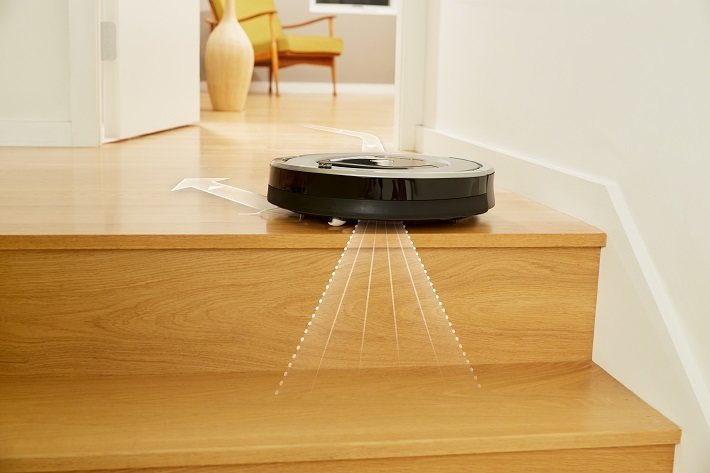
Ledges and stairs are a different story. Neither of the robots is apt to fall down a flight of stairs, the drop sensors on the bottom do an excellent job at preventing this. However, because the sensors are infrared and detect spacial distances, dark colors can confuse them. This means if you have a dark colored carpet the robot may avoid it thinking the dark areas are a ledge.
While this is rare, it does happen. The most common instances of this are when the flooring is a stark contrast (black and white checkered tiles, or black circles on a white rug). If you find this happening to you, this may be why.
Bottom Line: This round is a tie. Both robots have the sensors, and they both work on equal levels.
3. Side Brushes
Having a circular robot trying to clean along baseboards and in 90-degree corners is asking a bit much. With the addition of side brushes though, they are able to do a much better job.
Side brushes are little spinning brushes that collect dirt and debris from the front edges of the machines and sweep them towards the center where the extractors can pick them up. The Roomba 890 has a single side brush where the Ion 750 has dual side brushes.
At first glance I really thought the Ion 750 was on to something here, two is always better than one, right? However, after watching the robot run around for a while, I noticed the left-hand brush never really did anything. The robot always seemed to run along the edges on the right-hand side, proving the left-hand brush basically useless.
This isn’t to say it didn’t do anything because it did. The left spinning brush swept up dirt from the floor and put it in the path of the robot with ease. My only issue was that it was dirt in the center of the floor that would have been picked up by the robot on the next pass anyway.
Still, it did make the cleaning process all the easier, so two is still better than one.
[easyazon_image align=”center” height=”500″ identifier=”B075JRB2Z9″ locale=”US” src=”https://smartrobotichome.com/wp-content/uploads/2018/05/61g169edEUL.jpg” tag=”srh-easyazon-20″ width=”500″]Bottom Line: Ion 750 wins this round. Two will almost always be better than one.
4. Extractors
If two side brushes are better than one, then wouldn’t two extractors be better than one? Roomba seems to think so. The 890 has two extractor bars that spin in opposite directions. They have wedges that interlock as they go around, effective at picking up dirt and debris to be suctioned up by the air flow.
The Ion 750 has a single rotating bar that has bristles on it like so many upright vacuums. The bar does extend near the entire width of the robot though, so the cleaning path is slightly larger than that of the Roomba.
The downside to these extractors is the maintenance. As we all know, anything that rotates over our floors will collect hairs, string, and threads that will get tangled eventually.
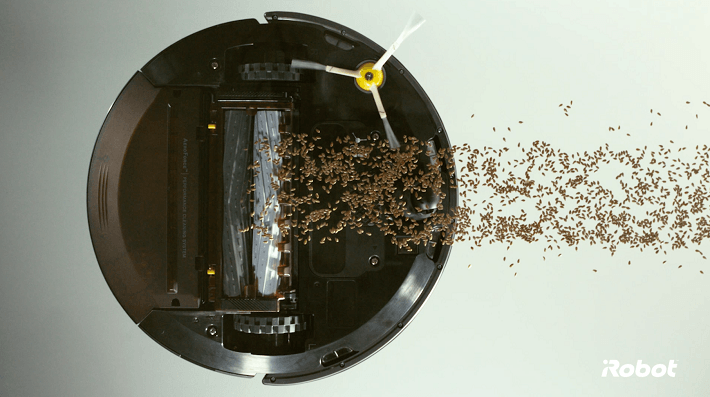
The Roomba 890 helps the maintenance by removing the bristles from the extractor bars. It makes for fewer tangles overall. IRobot also makes removal of the extractor bars simple and to clean them off of the hair and strings that do get wrapped around; you just have to wipe them off.
Shark addresses the issue by having a self-cleaning brush bar. Basically, they have added a stationary brush that the bar rotates through. This stationary brush picks off the hairs and strings as the brush bar goes around. I will say I was impressed with the efficiency of this device; however, things still got tangled as they are apt to do.
Because the brush bar has, well… brushes, maintenance is a little more difficult. You have to remove the brush bar, which isn’t made easy, and hand pick the hairs and strings off, just like you are used to doing with your upright vacuum.
All in all, I was able to remove, clean and replace the Roomba 890 and have it back in service in a little more than five minutes. The same process with the Ion 750 took me just shy of 10 minutes.
Bottom Line: Roomba wins. Things will get tangled, but maintenance is a lot simpler on the Roomba 890.
5. Batteries and Recharging
Both of the bots come with lithium-ion rechargeable battery packs. The docking station will automatically recharge the batteries when the robot returns and docks.
When the batteries are dead, the Roomba 890 will take right at two full hours to completely recharge. Once fully charged the 890 will scoot about cleaning floors for up to one hour. This is under optimal conditions, of course. Having the robot spot clean or on heavily soiled areas where it needs to use more battery power, the battery will last less than a full hour.
One hour of total cleaning time, though, is usually more than enough to clean between 1000 and 1400 square feet. This again depends on the floor type, more hard flooring, and less carpet means more area covered.
The Ion 750 will charge its batteries in just about three full hours. Once it is full of power and ready to go, it too will run for up to a full hour on that charge. As with the Roomba, this is under optimal conditions.
The Ion 750 runs slightly (as in barely noticeable) slower than the Roomba but because of the reduction in speed (and I believe the dual side brushes) the max area cleaned under perfect conditions is going to be about 1250 square feet.
Both robots will detect when their batteries are running low on charge and will find their way back to the docking station to recharge, without you having to do anything. Neither of the botvacs, though, will resume cleaning after the batteries are charged until you manually tell them to, or the next cleaning schedule time comes up.
The ability to recharge and resume is known as “Entire Level Cleaning,” and so far is only available on the 900 series Roomba models (not all of them, mind you).
Bottom Line: Roomba wins this round. A faster recharge time coupled with a larger total area of coverage makes it just that much better.
6. Barriers
Sometimes we don’t want our little robotic friends to clean every room that has been previously mapped out. So what do we do? You can shut a door, causing the robot to bounce off and remap the area. You can also put things in the way such as baby gates or furniture.
[easyazon_image align=”center” height=”333″ identifier=”B06XS31V18″ locale=”US” src=”https://smartrobotichome.com/wp-content/uploads/2018/05/41NEmocIWOL-1.jpg” tag=”srh-easyazon-20″ width=”500″]This is a lot of work though. Roomba uses Virtual Wall Barriers (VWB) that you can set up for these instances. These are little battery operated towers (batteries are included) that will send out an infrared beam across a doorway.
When the Roomba comes along the beam will tell the robot to go back. The Roomba will not cross the beam. Further, you can set the VWB to radius mode. This will create a circle beam about three feet in diameter around the tower. This is useful if you have pets or floor vases, plants or things you don’t want the vacuum to run into of over.
The Ion 750 also has a solution for you in the manner of BotBoundary Strips. Each Ion 750 comes with nine feet of the BotBoundary strip and two activators. You measure the area you want to block off (a doorway, or around a vase, plant, etc.) and cut the strip to size. You then clip the activators to each end, and it creates an infrared signal that prevents the bot from crossing over.
[easyazon_image align=”center” height=”500″ identifier=”B075JRB2Z9″ locale=”US” src=”https://smartrobotichome.com/wp-content/uploads/2018/05/61hUO6iNA3L-1.jpg” tag=”srh-easyazon-20″ width=”500″]Both methods work very well, and I have yet to see either robot disobey the IR beam. However, the Virtual Wall Barriers are so much easier to set up and use. You also don’t have to measure, cut and place strips down to use them, like with the Ion 750.
Bottom Line: Roomba 890 wins. While both method work, VWB just works a lot faster and easier.
7. Mobile App and Voice Controls
With mobile devices and apps gaining popularity infrared remote controls are becoming a thing of the past. Robotic vacuums are staying with technology. Both the Roomba 890 and the Ion 750 utilize mobile apps for control of the robots.
The apps are available for both iOS and Android phones and tablets. You can create schedules, edit and delete schedules and start, pause, or cancel cleanings.
You can also use the apps to see status reports, mark areas for spot cleaning and, in the case of the Roomba, give your robot a name.
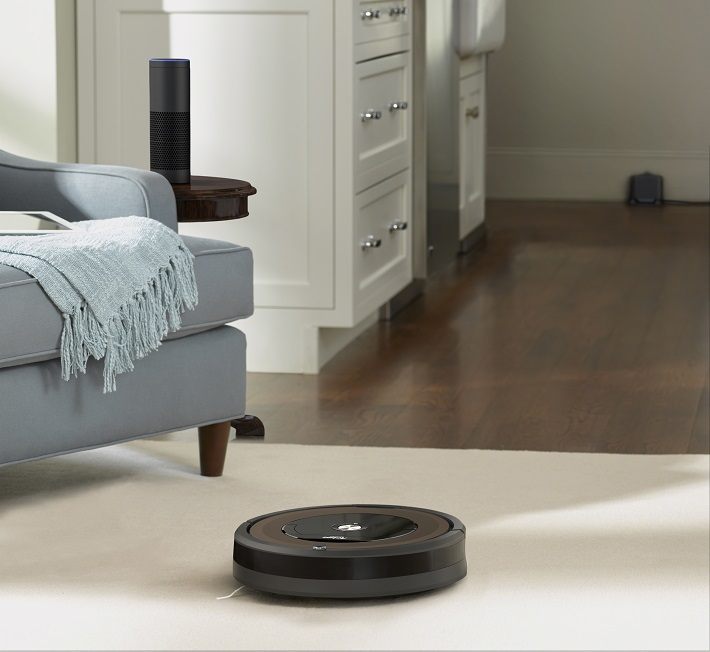
Each of the robovacs also allows voice control operations through Amazon Alexa or Google Home. If you happen to have more than one Roomba, you will be required to give them names to differentiate voice controls for them.
Bottom Line: This round is a tie. Both robots use voice commands and mobile apps for complete control very well.
8. Spot Cleaning
Each contestant here offers spot cleaning mode. This is a special mode where the robot will clean a specific spot based on your commands. They both clean in a similar manner during a spot clean.
When selected, spot clean mode will activate the robot to the specific area. From this point, the robot will do a deeper clean than normal while spinning in an ever-growing circular pattern. The Ion 750 will extend about four feet from the central area while the Roomba will go out about three feet.
Once finished they will return to the dock or resume the cleaning cycle it was on when spot mode was activated. The major difference here is that the Roomba will use the dirt detection sensors to ensure the area is clean before moving on. The Ion 750 will make three passes in an ever-widening circular pattern and then resume.
Bottom Line: The Roomba wins. Only because it ensures the area is clean before moving on.
9. Dust Bins
One downside of a robot vacuum is that they can’t clean themselves. You will be required to empty the dust collection bins on a regular basis.
Each vacuum has an easily removable dust bin that you just remove, empty and replace. The Ion 750 has a smaller dust bin than the Roomba 890 and will need to be cleaned out more regularly. In fact, Shark recommends you empty the bin out after every use.
Roomba can typically go two to three full cleaning cycles before needing to be emptied. However, there is a dust bin sensor that when triggered will alert you that the dust bin is full and needs to be emptied.
You will have the option to ignore the alert and continue with the cleaning or stop the cleaning and empty the dustbin.
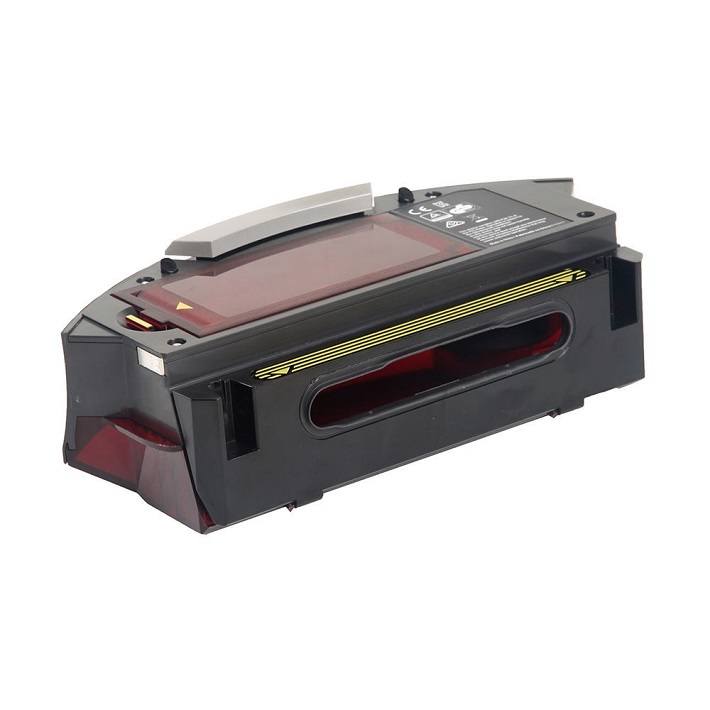
Bottom Line: Roomba wins. Not having to do the maintenance after every use is a bonus, and being told when the bin is full help.
Frequently Asked Questions
You have questions, and I have the answers. Here I provide you with answers to the most commonly asked questions about the Shark Ion 750 and the iRobot Roomba 890.
Q. Which is better, Roomba or Shark?
Shark vacuums tend to have stronger suction per dollar spent, but Roombas are more reliable and have better software. Both vacuums will get the job done.
Q. Can either of these robots continue where they left off?
A. You are referring to what iRobot calls the “recharge and resume” feature, where the robot has to end its current run due to a depleting battery. Unfortunately, this feature is only available on Roombas that has a model number beginning in “9” and is missing in Shark vacuums altogether.
Q. I have a dark colored floor, and the Ion 750 avoids it, what can I do?
A. You can always paint your floor a lighter color(?!). Failing that option there are reports that disabling the drop sensors with a piece of tape will also work. I do not recommend this at all (Hi, legal team!).
However, if you do not have ledges or stairs to worry about, it might be a viable option for you. I have also heard that placing the robot directly on the darkest spot and starting the cleaning cycle will also work.
Q. Can you program the robots manually or do I have to use the mobile app?
A. In short, you will have to use the mobile app. If you just want the little guys to run out and clean your floors, you can just depress the button on the top of the machines.
However, if you want to create schedules or the like, you will need to use the app. The process is very simple. However, there are a lot of options that a top panel push button just can’t handle. It would be akin to me writing this entire article on a T9 keypad.
If the problem is lack of internet, you have further options. Your home computer (most of them, post 2011) can create a home wireless network (no internet needed) that will allow devices such as your cell phone and robot vacuum to talk to each other.
Q. Can I use these to clean any floor type?
A. The short answer here is that both the Roomba 890 and Ion 750 are rated for all floor types. That being said I feel I must mention this here: carpet is a single type, even though there are many types of carpet.
[easyazon_image align=”center” height=”500″ identifier=”B06XS31V18″ locale=”US” src=”https://smartrobotichome.com/wp-content/uploads/2018/05/516dmw6G4tL.jpg” tag=”srh-easyazon-20″ width=”500″]The Roomba 890 will clean any type of carpet without much fuss. There will be snag problems on long shag carpeting, however short shag and high pile carpet is no problem.
The Ion 750, however, fails here (and was the ultimate factor in my final decision). The Ion 750 works just fine on low pile carpet. It actually cleans just as good as the Roomba does. However, anything over low pile will have issues.
Medium pile carpeting (wool Berber anyone?) will be enough to choke it out. High pile or shag will outright throw an error. The problem is that I believe Shark concentrated on being low profile to say they can fit under furniture better than the Roomba (which they can, kind of), but in doing so had to drop the deck so low it struggles on carpet.
I may be alone here (I doubt it), but a vacuum that struggles on carpet isn’t a big selling point. However, to answer your question, yes, they are rated for all floor types, the Ion 750 though is not rated for all types of floors.
Q. How often will the robot bang against my walls?
A. However long it takes you to quiet down over there! Some of us are trying to sleep!
The Roomba 890 will rarely knock into walls, doors or baseboards. It has infrared sensors that alert it to barriers. The Ion 750 however, will constantly do this. The Ion relies on pressure sensors only for obstacle detection. While this isn’t a bad thing, you may think that your little guy may need to wear a helmet.
It doesn’t. This is how it knows where the walls are. It doesn’t go fast enough to cause damage or leave marks (unless you have oil-based paints, more in a minute) along your baseboards.
Now, if you can take your fingernail and make a tiny bubble or mark on your walls, you have an oil based paint; latex and the like. One issue with these paints is that they actually take years to cure and dry fully. By years I mean eight to 10. This is why you can dig with your fingernail and move the paint around without chipping it off.
If you find that you have this type of paint, there is a small chance that the Roomba and the Ion will leave a mar on the baseboard if and when they come in contact with it. The good news is, that unless there are previous scratches or dents, the marks will wipe right off.
Q. I have oriental rugs with long fringe, will this be a problem?
A. Only if your significant other hates oriental rugs. However, I assume you mean with the robots get caught. Your answer: most likely.
The Ion 750 doesn’t have the capability to tell the difference between large debris and carpet fringe. It will attempt to pick it up, get tangled and give you an error code.
Likewise, the Roomba will also not be able to tell the difference, at least at first. The brushless extractor bars are also tangle free. What this means is that if something gets caught, such as oriental carpet fringe, the robot will reverse the extractors and attempt to free itself. If it cannot, then you will get the error code.
I suggest you roll the fringe underneath the rug when the cleaning is ongoing.
Q. Will this clean every room at once?
A. No. It will only clean one place at a time. However, each robot vacuum will travel to many different rooms and clean them in turn, but all at once is impossible.
What I assume you are asking is if it will clean your entire home in one charge. The answer depends on the total size of the floor and what type of flooring you have. It will be safe to say that regardless of floor type, each robot vacuum will clean at least 1000 square feet on a single charge.
What I Like About The Ion 750
- Automatic recharging when the battery gets low.
- HEPA filtration for allergy sufferers.
- Scheduling ability for away from home cleaning.
- Voice controls are easy to use.
- Side brushes work to move dirt and debris to the center.
- Brush bar self-cleaning works better than expected.
What I like About The Roomba 890
- Drop and Bump sensors work really well.
- Spot cleaning ensures the area is completely clean.
- Full bin indicator takes guesswork out of maintenance.
- Brushless extractors are quick and easy to clean.
- The mobile app is user-friendly and very intuitive.
In Conclusion
Two robots enter battling for supremacy in the battlefield of home dirt. Which one is right for you, though? The Shark Ion 750 was promising as the “Roomba Killer,” and even came quite close for me.
If you are looking for a cheaper alternative to a Roomba, want a good clean with WiFi enabled controls, voice commands, and scheduling, the Ion 750 could be your machine. Unless you have a lot of carpets or the carpet you do have is medium to high pile. If this is the case, you will most likely end up more frustrated than satisfied.
On the other hand, if you want all of that same stuff and the ability to use it on any floor type (and type of floor) the Roomba 890 will make the top of your list. Everything about the Roomba is just a little bit better, and for the money saved with the Shark Ion 750, those slight improvements may not be enough for you.
For me, though, they were, and that is why the Roomba 890 is the winner today.
Click here for all the robot vacuum deals on Amazon today.
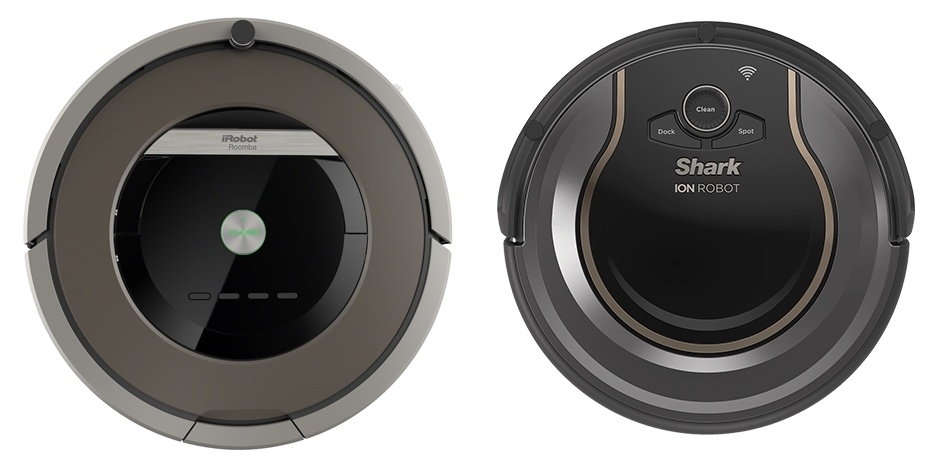
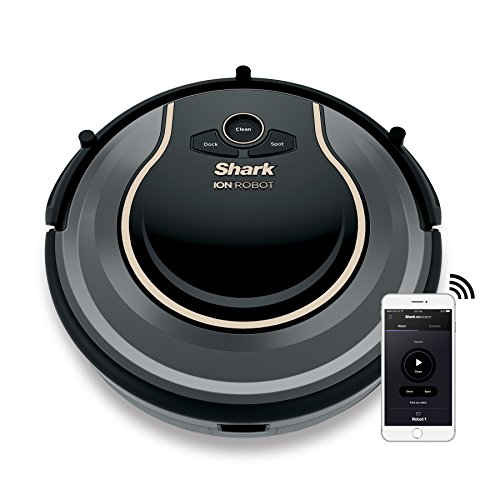
I have old roomba 770 and it cleans randomly. now it runs 5 minutes and goes backwards, then goes in a circle in its own track then stops. i am sure it needs a battery, it has never had one, but with running the wrong way is it worth it to have it looked at or replace it. what is best for cleaning needs? all hardwood and laminate floors i clean it regularly and blow it out with air hose. new filters every 2 months, new brushes every 6 months. it runs every day. we have 3 cats and fur.
thanks
bruce
Hi Bruce,
I usually recommend people get the Roomba 960 because (1) it has smart navigation (not random bump and turn navigation) and (2) it has brushless rollers, which are easy to maintain, and (3) it is time-tested. Owners of this vacuum when it released in 2016 still love it.
The Roomba S9+ blasts the comparable SHARK out of the water. And no it does not out perform SHARK with regards to suction.
The Roomba S9+ is the best on the market as of today. But it is definitely NOT for the budget conscience.